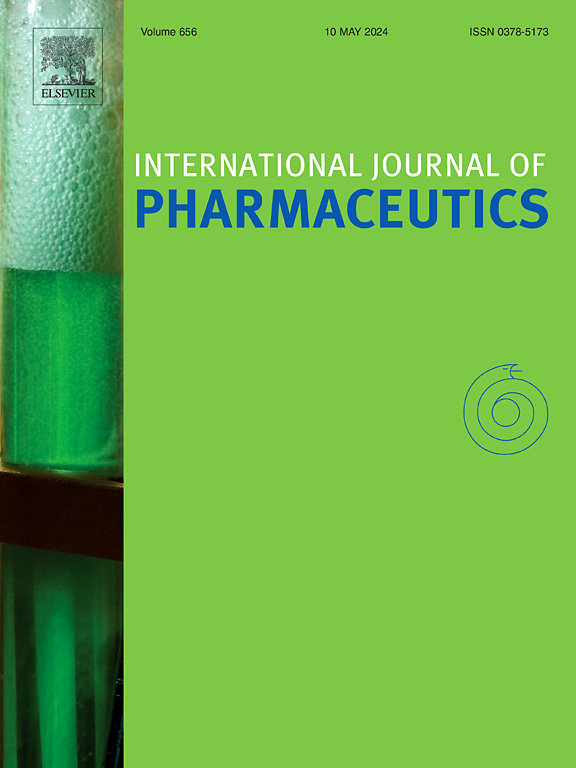Development of a stable inhalable dry powder formulation with osteoglycin fragment for alveolar epithelial repair
IF 5.3
2区 医学
Q1 PHARMACOLOGY & PHARMACY
引用次数: 0
Abstract
Chronic obstructive pulmonary disease (COPD) is characterized by irreversible airflow limitation and progressive lung function decline, with a critical need for innovative treatments that can repair damaged lung tissue. The active fragment of osteoglycin (OGN) has previously shown significant regenerative potential in activating growth of alveolar epithelial cells, making it a promising candidate for therapeutic development. In this study, we developed an inhalable dry powder formulation of the OGN fragment using spray drying, incorporating inulin or mannitol as excipients and leucine as a dispersion enhancer. The formulations were assessed for their ability to support lung organoid formation and differentiation in vitro. After spray drying with inulin or mannitol, the OGN fragment maintained its ability to induce organoid formation, but only the formulation containing inulin supported the differentiation towards alveolar-type organoids (surfactant protein C positive). After 28 days of storage at high temperatures (60 °C) inulin was found to provide superior stability compared to mannitol. The dry powder formulation with OGN fragment and inulin demonstrated favorable aerodynamic properties, meeting the requirements for deep lung deposition when dispersed via a dry powder inhaler. Additionally, we showed that adding 4 % leucine or inulin sweeper particles significantly improved the dispersion behavior of the formulation and reduced dry powder inhaler retention. This study highlights the potential of an inhalable OGN fragment formulation as a novel therapeutic approach for lung tissue repair in COPD. The findings support further development and clinical evaluation of this formulation, particularly with inulin as the preferred stabilizing excipient.

用于肺泡上皮修复的稳定可吸入干粉制剂与骨苷片段的研制
慢性阻塞性肺疾病(COPD)的特点是不可逆的气流限制和进行性肺功能下降,迫切需要能够修复受损肺组织的创新治疗方法。骨苷活性片段(OGN)在激活肺泡上皮细胞生长方面显示出显著的再生潜力,使其成为治疗开发的有希望的候选物。在这项研究中,我们开发了一种可吸入的OGN碎片干粉配方,使用喷雾干燥,加入菊粉或甘露醇作为辅料,亮氨酸作为分散增强剂。评估了这些制剂在体外支持肺类器官形成和分化的能力。在用菊糖或甘露醇喷雾干燥后,OGN片段保持诱导类器官形成的能力,但只有含有菊糖的配方支持向肺泡型类器官分化(表面活性剂蛋白C阳性)。在高温(60°C)下储存28天后,菊粉被发现比甘露醇具有更好的稳定性。含有OGN碎片和菊粉的干粉配方表现出良好的空气动力学性能,通过干粉吸入器分散时满足深肺沉积的要求。此外,我们发现添加4%亮氨酸或菊粉清扫颗粒可显著改善配方的分散行为,并减少干粉吸入器滞留。这项研究强调了可吸入OGN片段制剂作为COPD肺组织修复新治疗方法的潜力。研究结果支持该制剂的进一步开发和临床评价,特别是菊粉作为首选的稳定赋形剂。
本文章由计算机程序翻译,如有差异,请以英文原文为准。
求助全文
约1分钟内获得全文
求助全文
来源期刊
CiteScore
10.70
自引率
8.60%
发文量
951
审稿时长
72 days
期刊介绍:
The International Journal of Pharmaceutics is the third most cited journal in the "Pharmacy & Pharmacology" category out of 366 journals, being the true home for pharmaceutical scientists concerned with the physical, chemical and biological properties of devices and delivery systems for drugs, vaccines and biologicals, including their design, manufacture and evaluation. This includes evaluation of the properties of drugs, excipients such as surfactants and polymers and novel materials. The journal has special sections on pharmaceutical nanotechnology and personalized medicines, and publishes research papers, reviews, commentaries and letters to the editor as well as special issues.

 求助内容:
求助内容: 应助结果提醒方式:
应助结果提醒方式:


